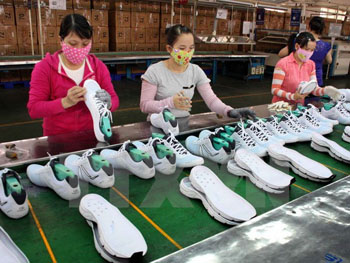Although China maintains its ranking as the biggest footwear manufacturer worldwide, its solid and leading position is starting to show the first signs of stress and difficulty. In fact, in recent years, it has experienced a significant slowdown in growth, and even registered a downtrend in 2016: despite all this, it continues to hold onto to an impressive share of global production that is equal to 59.1%. So, where has the 5% share lost by the Chinese giant been redirected? Essentially, it has been divided up between India, Indonesia, and above all, Vietnam.
By taking a look at export charts, the transfer of this share from China to Vietnam can clearly be seen. Having fallen below the mark of 10 billion pairs exported, while always maintaining first place in the classification of exporters, China has seen its global share decrease from 74% in 2012 to 69.1% in 2016. During the same period, Vietnam has gone up in the classification of top footwear exporters to second place, with a global export share equal to 7.3%, for more than one billion pairs exported at a value of more than 15 billion dollars (Source: World Footwear Yearbook 2017).
 These figures are sign of a growing preference for Vietnam as a destination for productive outsourcing. Compared to nearby China, Vietnam in fact is characterized by a series of advantages that make it a much more attractive productive partner: overall lower labour costs, greater availability of manpower, and greater attention to the themes surrounding Corporate Social Responsibility. Moreover, Vietnam is politically and economically stable, with a strong supply chain… Finally, another advantage is offered up by Vietnam’s participation in a number of free trade agreements, including the one with ASEAN – the Association of Southeast Asian Nations, to which Vietnam exports with Zero Duties; and the RCEP – Regional Comprehensive Economic Partnership, the proposed free trade agreement between the member states of ASEAN and Australia, China, India, Japan, South Korea, and New Zealand, which should be finalized by the end of 2017. The most important, however, is its participation in the TPP – Trans Pacific Partnership, which today is being threatened by the USA’s withdrawal, since the USA is also the first destination for Vietnamese footwear…
These figures are sign of a growing preference for Vietnam as a destination for productive outsourcing. Compared to nearby China, Vietnam in fact is characterized by a series of advantages that make it a much more attractive productive partner: overall lower labour costs, greater availability of manpower, and greater attention to the themes surrounding Corporate Social Responsibility. Moreover, Vietnam is politically and economically stable, with a strong supply chain… Finally, another advantage is offered up by Vietnam’s participation in a number of free trade agreements, including the one with ASEAN – the Association of Southeast Asian Nations, to which Vietnam exports with Zero Duties; and the RCEP – Regional Comprehensive Economic Partnership, the proposed free trade agreement between the member states of ASEAN and Australia, China, India, Japan, South Korea, and New Zealand, which should be finalized by the end of 2017. The most important, however, is its participation in the TPP – Trans Pacific Partnership, which today is being threatened by the USA’s withdrawal, since the USA is also the first destination for Vietnamese footwear…
The latest Vietnam Footwear Summit was accordingly dedicated to the opportunities offered by the Vietnamese footwear industry and the threats created by the USA’s withdrawal from the TPP. Organized by LEFASO – the Vietnam Leather, Footwear, and Handbag Association, and by ECV International, it was held this past 15 and 16 March at The Reverie Saigon Hotel in Ho Chi Minh City.

Thus, two days of lively debate and discussion took place between delegates of the footwear industry from all of Asia, outlining possible future scenarios for Vietnamese footwear, especially in light of the new trade policies that will be implemented by the Trump administration.  The withdrawal of the USA from the TPP is in fact a serious threat to the development of Vietnamese footwear business in the United States: in 2016, Vietnam exported 367.4 million pairs to the USA market for a value of 4.865 billion dollars, which is respectively +14.2% and +13% when compared to 2015. A performance that puts it at second place in the classification of USA suppliers, right after China, which during the same time period, sold 1,698.3 million pairs for a value of 14.653 billion dollars, in a downtrend that registered -10% in quantity and -13.1% in value (Source: Global Footwear Partnership LLC). The fear of Vietnamese exporters is that the American President Donald Trump will further limit access to the American market by implementing other protectionist measures, which could conflict with the expansionistic drive of Vietnam.
The withdrawal of the USA from the TPP is in fact a serious threat to the development of Vietnamese footwear business in the United States: in 2016, Vietnam exported 367.4 million pairs to the USA market for a value of 4.865 billion dollars, which is respectively +14.2% and +13% when compared to 2015. A performance that puts it at second place in the classification of USA suppliers, right after China, which during the same time period, sold 1,698.3 million pairs for a value of 14.653 billion dollars, in a downtrend that registered -10% in quantity and -13.1% in value (Source: Global Footwear Partnership LLC). The fear of Vietnamese exporters is that the American President Donald Trump will further limit access to the American market by implementing other protectionist measures, which could conflict with the expansionistic drive of Vietnam.
Also in the European Union, where Vietnam exports footwear with zero duties, Vietnam is the second supplier after China, with 239.9 million pairs exported in 2016 at a value of 3 billion dollars, as part of a rising trend both in quantity (+1.7%) and value (+4.9%).
These are the numbers and potential of the local footwear industry as outlined by the Vietnam Footwear Summit, to which can be added the themes concerning product development, applied technology, and opportunities for investment: an in-depth analysis that opens up new and interesting scenarios for the future development of Vietnamese footwear.



